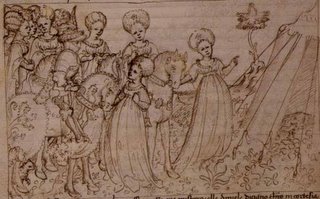




The legends associated with King Arthur, Sir Lancelot, the Knights of the Round Table, Merlin, the quest for the Holy Grail, the role of Lady Guinevere and the magical sword Excalibur, grew out of a number of literary sources in England and France from about the 11th century onwards.
The definitive version of these fictitious stories was Le Morte d'Arthur by Sir Thomas Malory, written in about 1470 - in time for the printing press of William Caxton to confer immortality onto the publication [1485]. The legendary motifs that persist today can be found in this version.
The images here are from a vellum manuscript in latin. There isn't any commentary and I have no idea whether or not it preceded Malory's work. If I had to lay money on it, I'd say it was written about the same time (or earlier as my 2nd guess). There are sketches on virturally every page: ~350 pages in total and they were done by probably 2 or 3 hands ranging from insipid to cartoon-like to Da Vinci-like. It's probable that the small amount of colouring of embellished letters and a couple of the sketches was added later. Some 30 or more pages are badly stained. But for the mostpart I thought it was an interesting work to flick through.
- La tavola rotonda, in volgare dialettale [essentially: 'The Round Table, in vulgate dialect'] (Manoscritto Palatino 556) is hosted by La Biblioteca Nazionale Centrale di Firenze.
- Putting 'King Arthur' or 'Sir Lancelot' into any search engine brings up a lot of results. I found the Arthurian Legend homesite to be easy to read, succinct and informative. They also have the wonderful 1940's Francoise Taylor engravings relating to the Arthurian story.
- Arthurian links from Dmoz and Voice of the Shuttle.
No comments:
Post a Comment